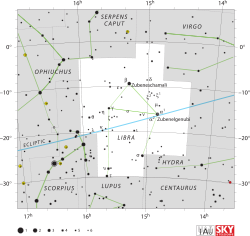Zubeneschamali
| Observation data Epoch J2000 Equinox J2000 |
|
|---|---|
| Constellation | Libra |
| Right ascension | 15h 17m 00.41382s |
| Declination | −09° 22′ 58.4919″ |
| Apparent magnitude (V) | 2.61 |
| Characteristics | |
| Spectral type | B8 V |
| U−B color index | −0.359 |
| B−V color index | −0.106 |
| Variable type | Suspected |
| Astrometry | |
| Radial velocity (Rv) | −35.2 km/s |
| Proper motion (μ) |
RA: −98.10 mas/yr Dec.: −19.65 mas/yr |
| Parallax (π) | 17.62 ± 0.16mas |
| Distance | 185 ± 2 ly (56.8 ± 0.5 pc) |
| Details | |
| Mass |
3.5+0.3 −0.2 M☉ |
| Radius | 4.9 R☉ |
| Luminosity | 130 L☉ |
| Temperature | 12300 K |
| Metallicity [Fe/H] | 0.33 dex |
| Rotational velocity (v sin i) | 250 km/s |
| Age |
80+50 −40 Myr |
| Other designations | |
| Database references | |
| SIMBAD | data |
Beta Librae (β Librae, abbreviated Beta Lib, β Lib), also named Zubeneschamali, is (despite its 'beta' designation) the brightest star in the zodiac constellation of Libra. From parallax measurements, its distance can be estimated as 185 light-years (57 parsecs) from the Sun.
The apparent visual magnitude of this star is 2.6. According to Eratosthenes Beta Librae was observed to be brighter than Antares. Ptolemy, 350 years later, said it was as bright as Antares. The discrepancy may be due to Antares becoming brighter, but this is not known for certain. It could simply be caused by Beta Librae being a variable star, showing a present-day variability of 0.03 of a magnitude.
β Librae (Latinised to Beta Librae) is the star's Bayer designation.
It bore the traditional name Zubeneschamali /ˌzuːbənˌɛʃəˈmeɪli/ (less common renderings, or corruptions, are Zuben Eschamali, Zuben el Chamali, Zubenesch, Zubenelg) derived from the Arabic ّالزُبَانَى الشَمَالِي (al-zubānā al-šamāliyy) meaning "The Northern Claw". There was also Kiffa Borealis, from the Arabic al-kiffah aš-šamāliyy "the northern pan (of the scales)" and the Latin equivalent Lanx Borealis. In 2016, the International Astronomical Union organized a Working Group on Star Names (WGSN) to catalogue and standardize proper names for stars. The WGSN approved the name Zubeneschamali for this star on 21 August 2016 and it is now so entered in the IAU Catalog of Star Names.
...
Wikipedia

